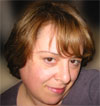(Continued from Installment 1)
Moto Hagio Interview (Installment 2)
*Even the fighting scenes were sexy
—They say Dr. Osamu Tezuka and the so-called Tokiwa-so generation cartoonists were actively incorporating cinematic approaches in manga and innovative compositions. What do you think were Ishinomori's individual characteristics in his approaches?
Hagio: I think the most singular characteristics of Mr. Ishinomori were his poetry and his delicate pen strokes. I think cinematic approaches and compositions existed before Dr. Tezuka, but he advanced the techniques in laying out the page with a literary sensibility to such a point that it felt like you were really watching a movie, flowing naturally from one panel to the next. Then I think Mr. Ishinomori adapted his style to something we can only call "Ishinomori Rhythm."
—Do you mean there was something particular to his style, that was different from Tezuka's?
Hagio: There are significant similarities among Mr. Ishinomori, Ms. Hideko Mizuno, and Dr. Tezuka in drawing styles and the overall flavor of their layout. Ms. Mizuno and Mr. Ishinomori even collaborated in the beginning. But there are individual characteristics nonetheless, and Ms. Mizuno's strokes were very gorgeous and glittering. Mr. Ishinomori's were delicate and fragile, especially when you see his work in shonen manga [magazines]—you notice that his contribution stands out for its delicateness, like a handsome boy in the middle of fearsome warriors. (laugh) Dr. Tezuka drew in a round style but his strokes were sharp and hard. They appeared very solid.
—And you, Hagio-san, were influenced by those pioneers, too?
Hagio: Today we can use various ways to divide a page into panels, but you seldom saw "Variable-shape Panels" in shonen manga magazines back then, and you could follow the panels in a flow. I learned such rhythms—the pacing—of the layout from them. Dr. Tezuka, Mr. Mitsuteru Yokoyama, Mr. Ishinomori, and Mr. Tetsuya Chiba, they all have their own pacing and stage direction. This may sounds strange, but you can follow all the lines in a balloon. I thought it was a given, but when I became a pro and Gekiga came out, I couldn't read in one breath all the lines in balloons because they were very verbose. (laugh) So I realized this was a very important technique. When it comes to Gekiga, I cannot read [balloons] without taking a breath in the middle. Then I forget what was depicted in the picture while I am reading.
—You ended up just following the lines.
Hagio:
Yes, yes! It just becomes an illustrated story. Cartoonists from Mr. Ishinomori's generation placed just enough lines in a balloon for one breath, no more, no less. It's not tiring to read them, and they were easy to absorb. Back then even my brain was plastic and flexible, so I could just remember a manga of this length (one-shot short) for about a year, with all compositions and lines. I absorbed them like photographic papers. But that didn't work for Gekiga. (laugh) [the rest is omitted from translation]
(Continues to Installment 3)

No comments:
Post a Comment